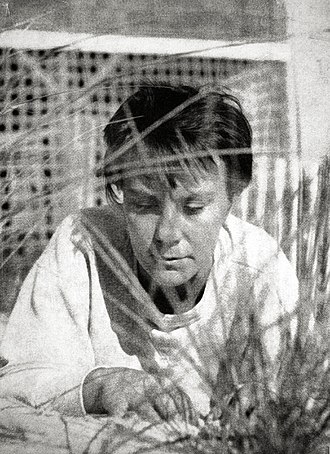Harper Lee

Nelle Harper Lee (April 28, 1926 – February 19, 2016) was an American novelist best known for her 1960 novel To Kill a Mockingbird. It won the 1961 Pulitzer Prize and has become a classic of modern American literature. Lee has received numerous accolades and honorary degrees, including the Presidential Medal of Freedom in 2007 which was awarded for her contribution to literature.[1][2][3] She assisted her close friend Truman Capote in his research for the book In Cold Blood (1966).[4] Capote was the basis for the character Dill Harris in To Kill a Mockingbird.[5]
The plot and characters of To Kill a Mockingbird are loosely based on Lee’s observations of her family and neighbors, as well as an event that occurred near her hometown in 1936 when she was 10. The novel deals with the irrationality of adult attitudes towards race and class in the Deep South of the 1930s, as depicted through the eyes of two children. It was inspired by racist attitudes in her hometown of Monroeville, Alabama. She also wrote the novel Go Set a Watchman in the mid-1950s and published it in July 2015 as a sequel to Mockingbird, but it was later confirmed to be her first draft of Mockingbird.[6][7][8]
Nelle Harper Lee was born on April 28, 1926, in Monroeville, Alabama[9] where she grew up as the youngest of four children of Frances Cunningham (Finch) and Amasa Coleman Lee.[10] Her parents chose her middle name, Harper, to honor pediatrician Dr. William W. Harper, of Selma, who saved the life of her sister Louise.[11] Her first name, Nelle, was her grandmother’s name spelled backwards and the name she used,[12] Harper Lee being primarily her pen name.[12] Lee’s mother was a homemaker; her father, a former newspaper editor, businessman and lawyer, also served in the Alabama State Legislature from 1926 to 1938. Through her father, she was a descendant of Confederate General Robert E. Lee and a member of the prominent Lee family.[13][14] Before A.C. Lee became a title lawyer, he once defended two black men accused of murdering a white storekeeper. Both clients, a father, and son, were hanged.[15] Lee had three siblings: Alice Finch Lee (1911–2014),[16] Louise Lee Conner (1916–2009), and Edwin Lee (1920–1951).[17] Although Nelle remained in contact with her significantly older sisters throughout their lives, only her brother was close enough in age to play with, though she grew closer with Truman Capote (1924–1984), who visited family in Monroeville during the summers from 1928 until 1934.[18]
While enrolled at Monroe County High School, Lee developed an interest in English literature, in part because teacher Gladys Watson became her mentor. After graduating from high school in 1944,[10] like her eldest sister Alice Finch Lee, Nelle attended the then all-female Huntingdon College in Montgomery for a year, then transferred to the University of Alabama in Tuscaloosa, where she studied law for several years. Nelle Lee also wrote for the university newspaper and a humor magazine, but to her father’s great disappointment, left one semester before completing the credit hours necessary for a degree.[19][20] In the summer of 1948, Lee attended a summer school in European civilization at Oxford University in England, financed by her father, who hoped—in vain, as it turned out—that the experience would make her more interested in her legal studies in Tuscaloosa.[21]
In the spring of 1957, a 31-year-old Lee delivered the manuscript for Go Set a Watchman to Crain to send out to publishers, including the now-defunct J. B. Lippincott Company, which eventually bought it.[25] At Lippincott, the novel fell into the hands of Therese von Hohoff Torrey—known professionally as Tay Hohoff. Hohoff was impressed. “[T]he spark of the true writer flashed in every line”, she would later recount in a corporate history of Lippincott.[25] But as Hohoff saw it, the manuscript was by no means fit for publication. It was, as she described it, “more a series of anecdotes than a fully conceived novel”.[25] During the next couple of years, she led Lee from one draft to the next until the book finally achieved its finished form and was retitled To Kill a Mockingbird.[25] Meanwhile, interest in racial relations in the South had increased nationally as the U.S. Supreme Court had issued its school desegregation decisions in Brown v. Board of Education in 1954, and the civil rights movement as well as the segregationist “massive resistance” strategy made headlines across the nation.[citation needed]
Like many unpublished authors, Lee was unsure of her talents. “I was a first-time writer, so I did as I was told,” Lee said in a statement in 2015 about the evolution from Watchman to Mockingbird.[25] Hohoff later described the process in Lippincott’s corporate history: “After a couple of false starts, the story-line, interplay of characters, and fall of emphasis grew clearer, and with each revision—there were many minor changes as the story grew in strength and in her own vision of it—the true stature of the novel became evident.” (In 1978, Lippincott was acquired by Harper & Row, which became HarperCollins which published Watchman in 2015.)[25] Hohoff described the give and take between author and editor: “When she disagreed with a suggestion, we talked it out, sometimes for hours” … “And sometimes she came around to my way of thinking, sometimes I to hers, sometimes the discussion would open up an entirely new line of country.”[25]
